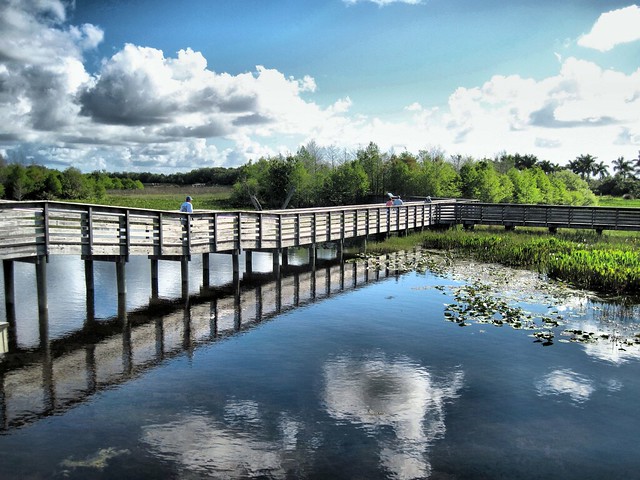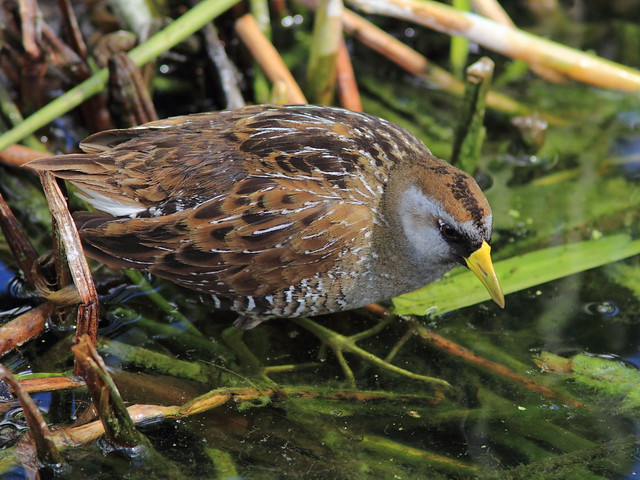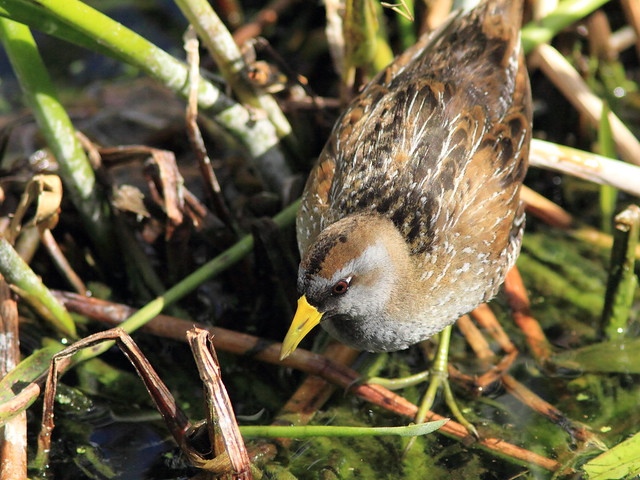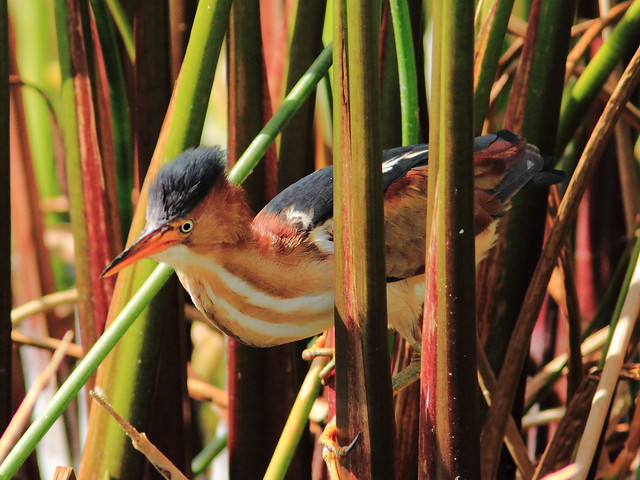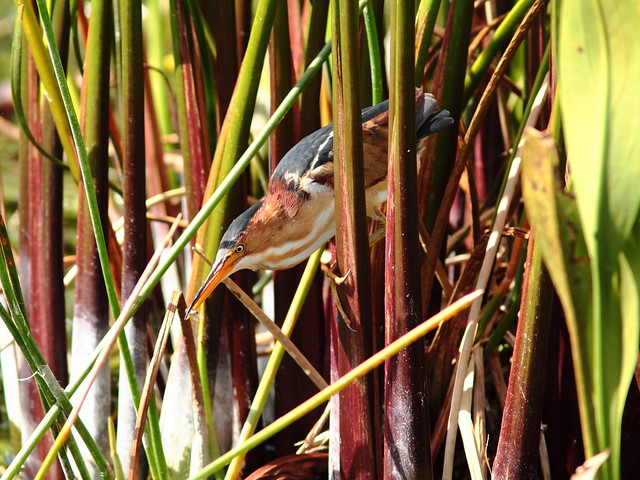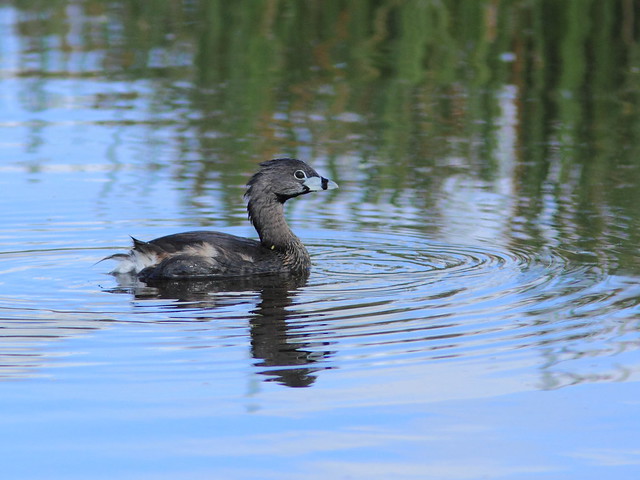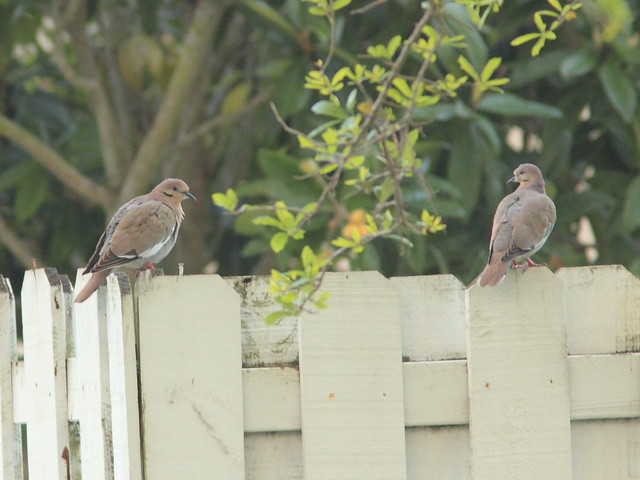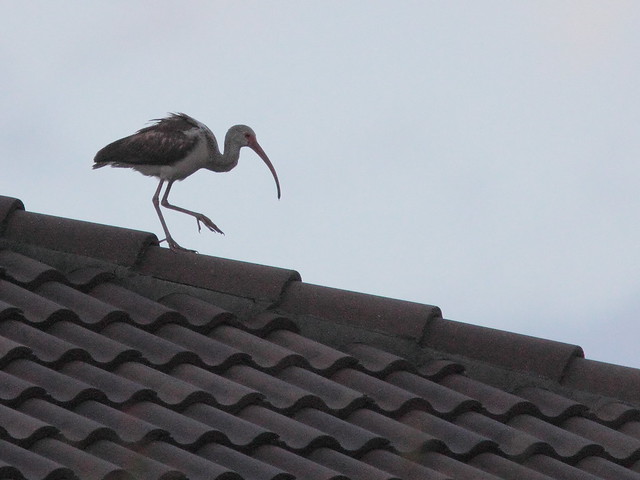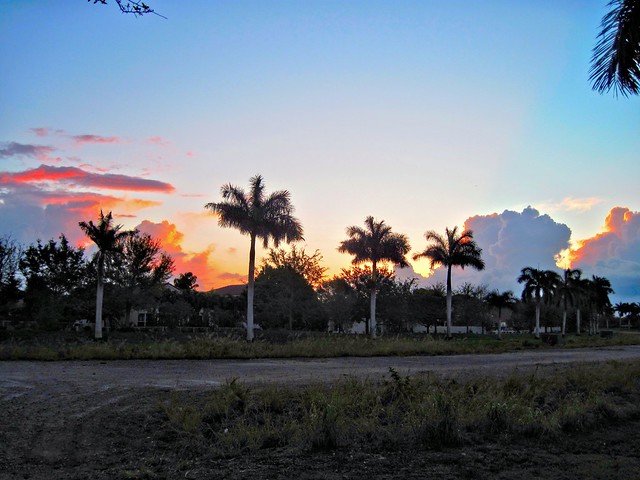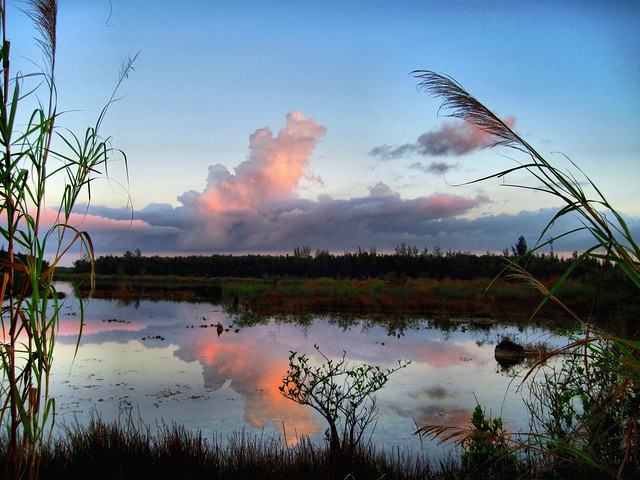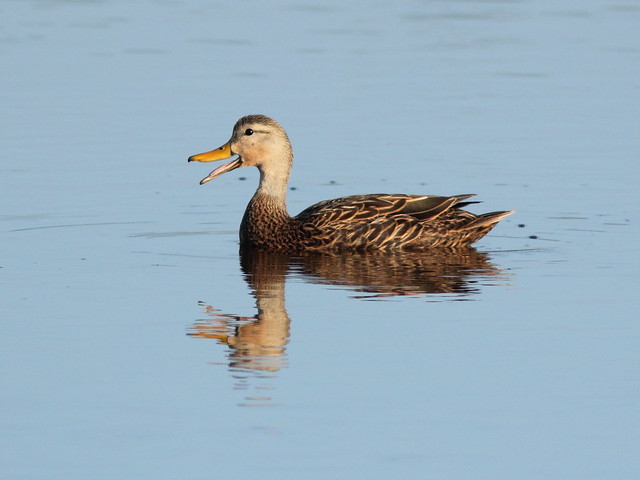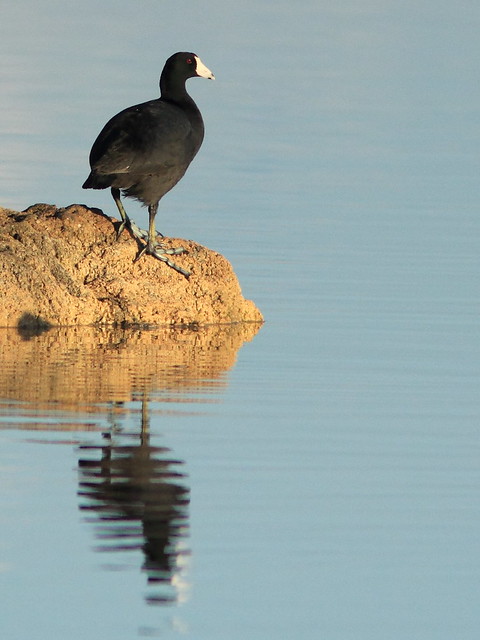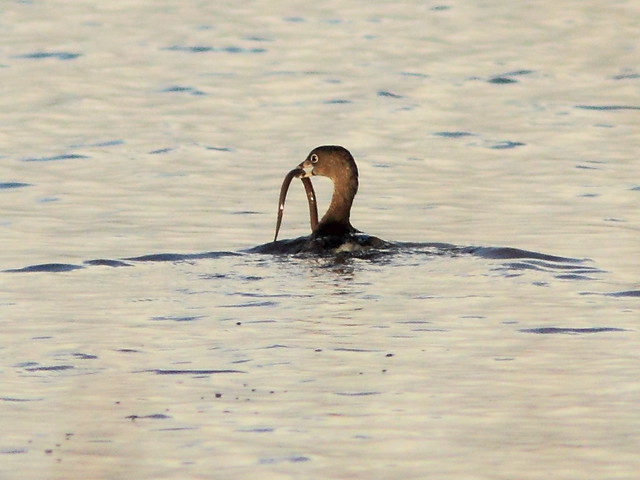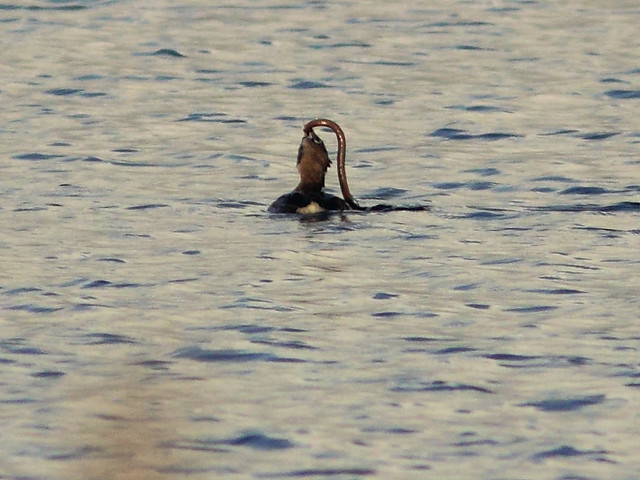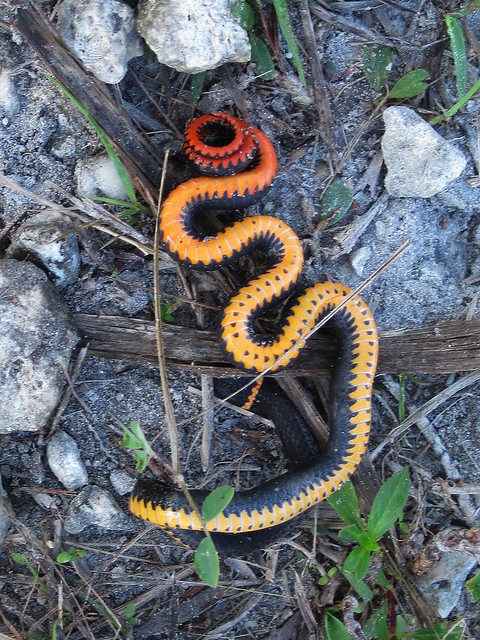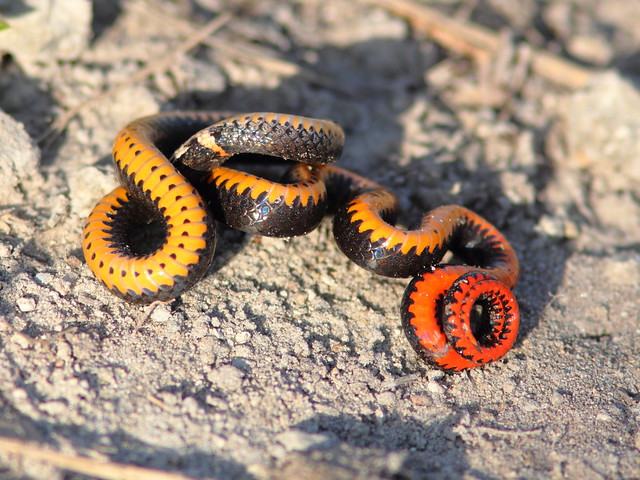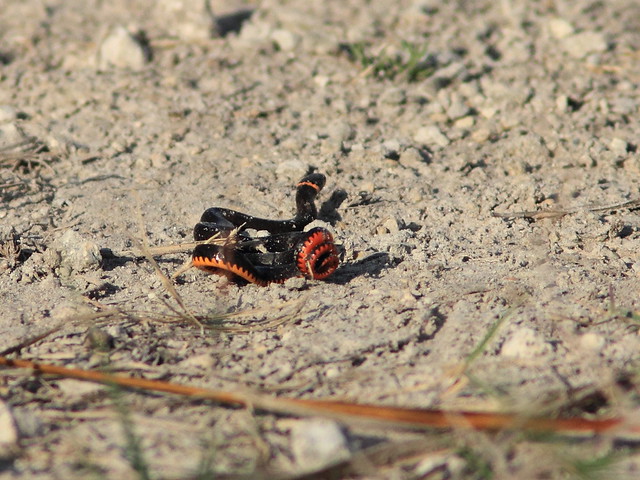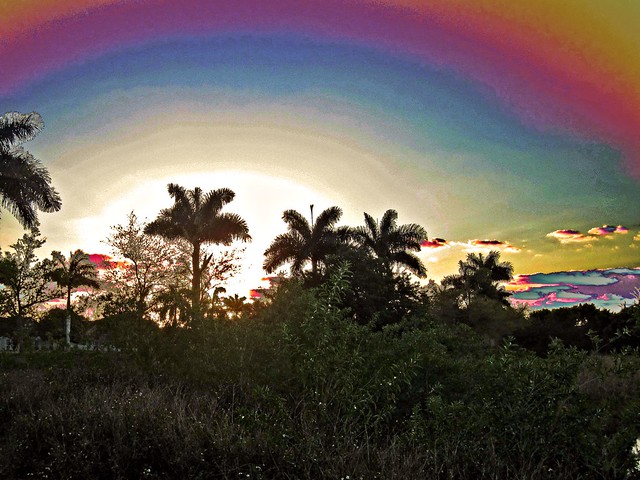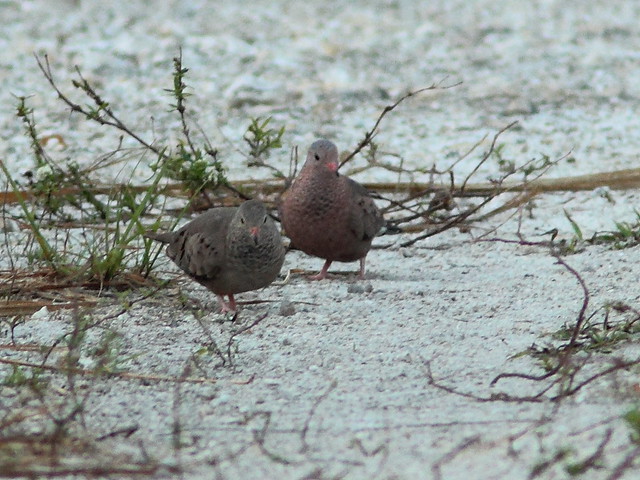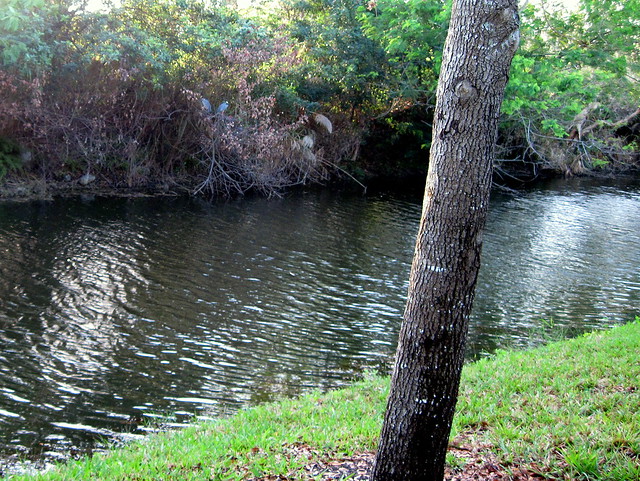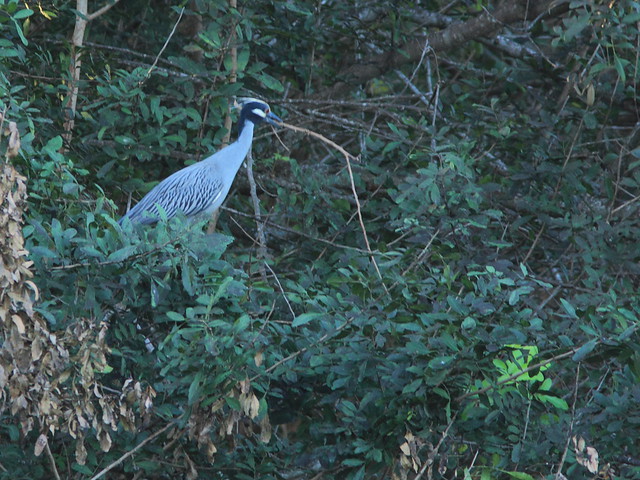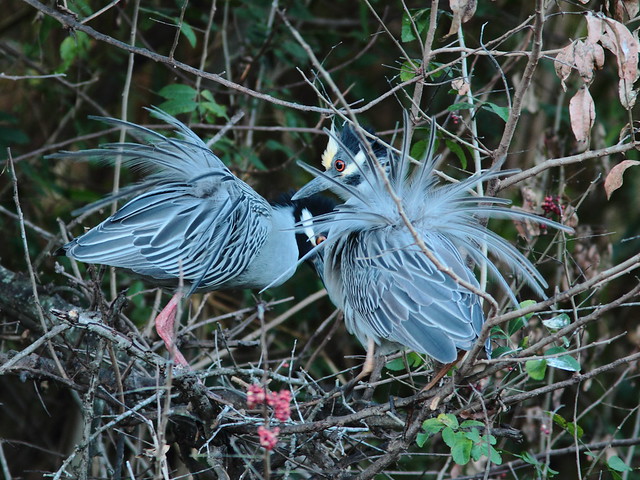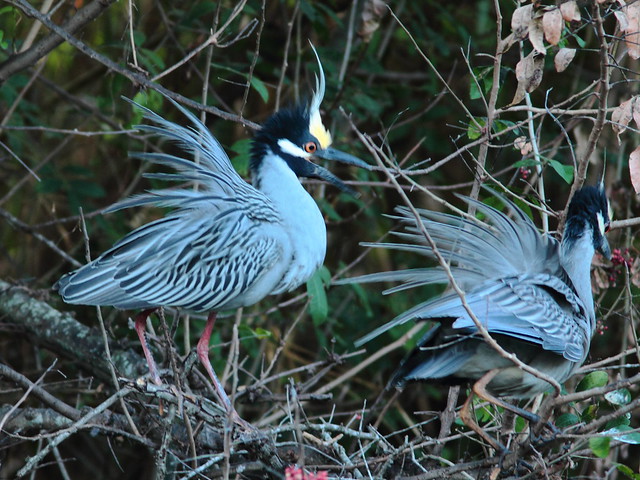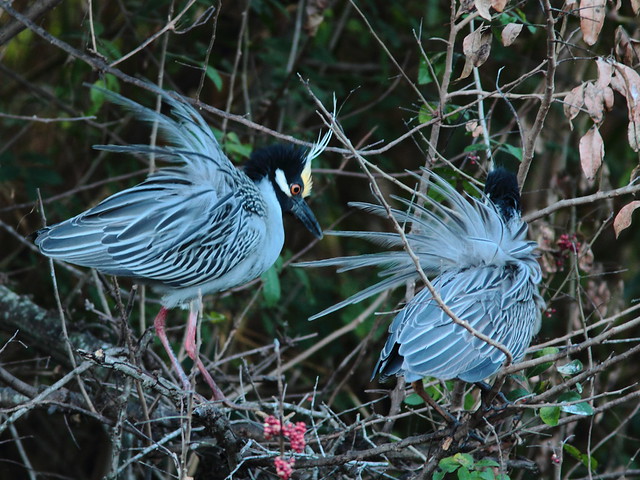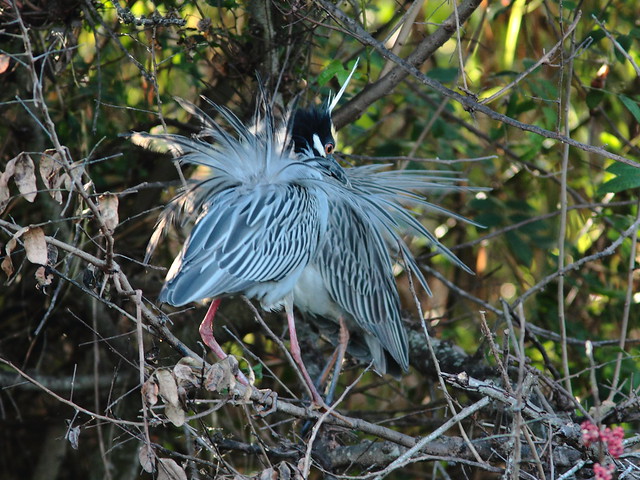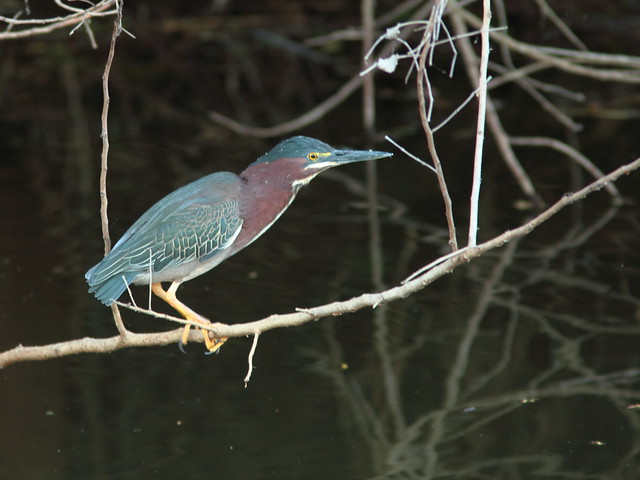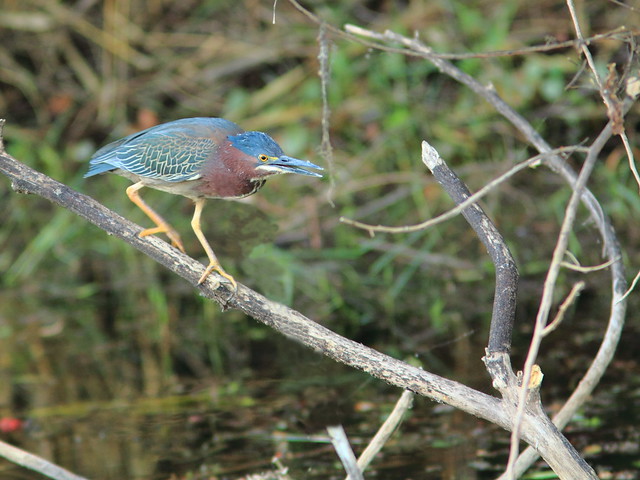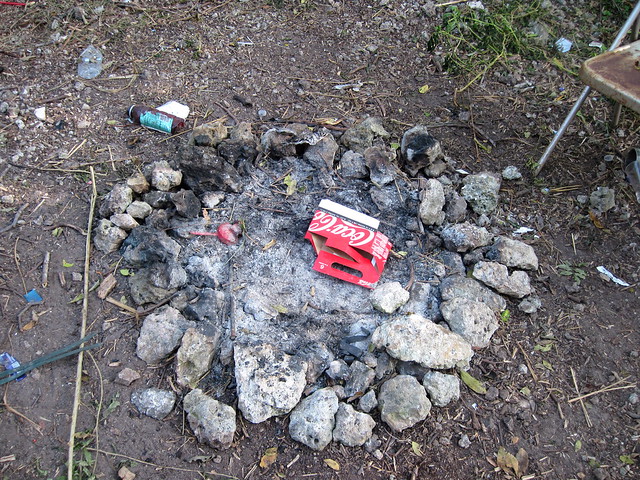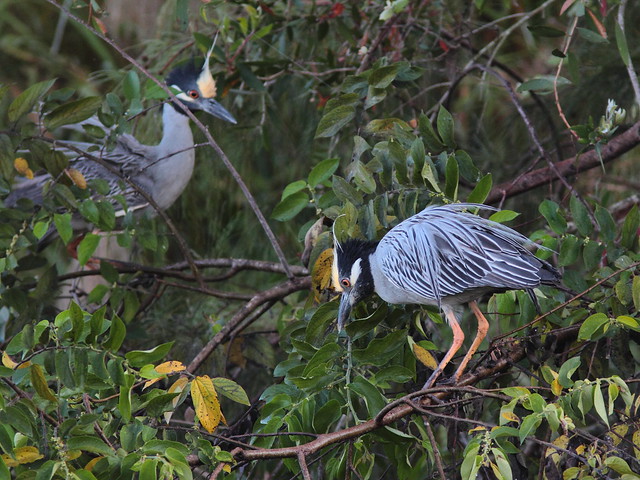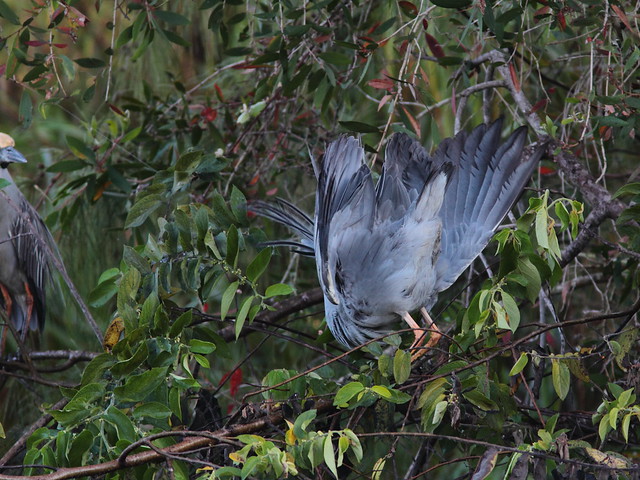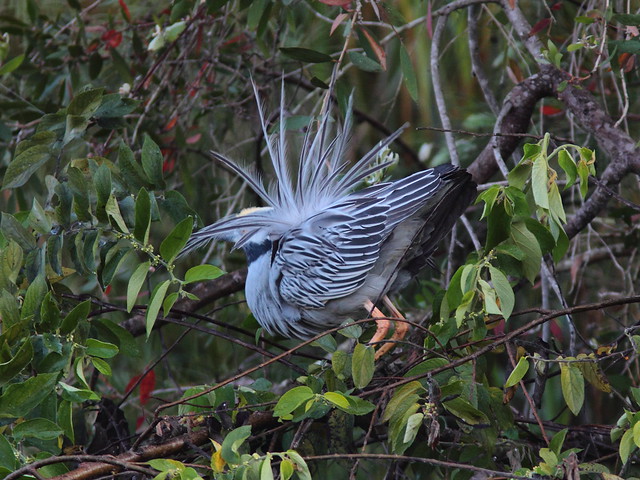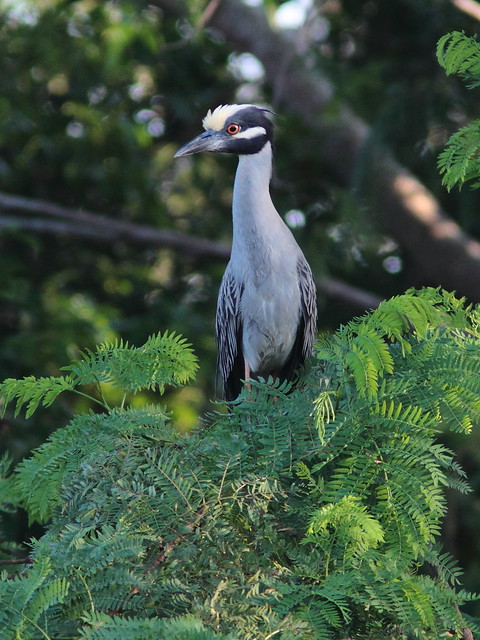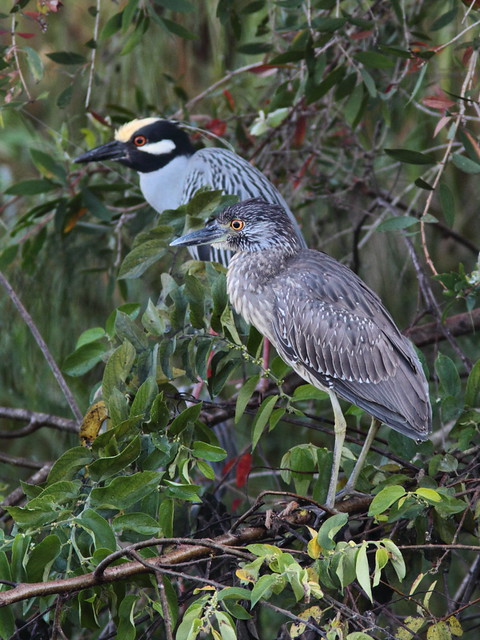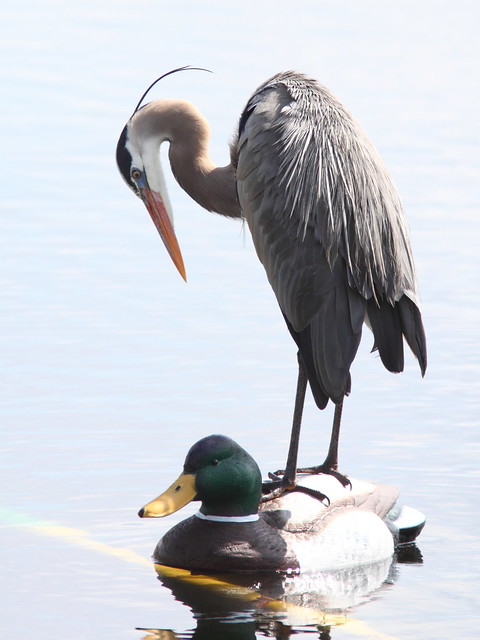Posted by: Ken @ 12:12 pm
Any birder visiting South Florida just can’t miss stopping at three special places in western Palm Beach County: Loxahatchee National Wildlife Refuge, Wakodahatchee Wetlands, and Green Cay Nature Center. The latter, in Boynton Beach, was our objective as we traveled up to have lunch with one of my “old” classmates. When I say old, I mean it in the classic sense, as we started kindergarten together and were in the same grades all the way through grammar school and graduated together from the same high school. Our meeting place for lunch was a little over an hour’s drive from our home, and Green Cay was a convenient place to stop on the way.
This is the 9,000 square foot Nature Center.
Purists might argue that Green Cay is a rather artificial place. Indeed, it is quite a new habitat, a domestic waste water treatment plant that opened to the public only seven years ago. But what a place it is! Green Cay’s 175 acres include 100 acres of wetlands with a mile and a half of boardwalks that traverse open lakes, ponds and sloughs, varied marsh habitats, cypress stands, and several dry islands.
This is one of the cypress-covered islands.
Unlike so many “sewage ponds” that attract birders, there are no bad odors at Green Cay. The crystal-clear water that enters has been well treated to remove nearly all the suspended and dissolved biological substances, and Green Cay is the final stage of treatment. Yet it is fertile enough to support a rich growth of plant life that purify and filter the water. When it flows out of Green Cay, so-called tertiary effluent, the water can safely be used for agriculture or be discharged into waterways.
The boardwalk runs along the edge of a large lake.
Green Cay is a big hit with local residents and casual visitors as well, and it’s best to get there early if you want to find a convenient place in the huge parking lot. Overheard, a grandmother talking to her little grandson and granddaughter: “Are you happy I brought you here?” The little girl replied: “Grandma, I really like this place.” The boy cried out gleefully: “I love it!”
A Great Blue Heron tends its chick right next to the boardwalk.
A Great Egret catches some salad to go with the fish.
One interesting thing about the place is that the wildlife have become accustomed to having all the people around. Herons, Limpkins and rails forage along the boardwalk, seemingly unconcerned. What a difference from the wetlands near our home, where the only visitors besides a few birders and joggers are kids on ATVs. We are lucky to get a fleeting glance at a bittern or a raptor… or a Bobcat.
Our target species for this visit were the Sora and the Least Bittern, both of which had recently been reported at Green Cay. We were not disappointed.
The Sora was most cooperative.
We especially hoped to see one or more of the family of Bobcats that have been thrilling photographers with close-up views. When we arrived there at about 9:30 in the morning, we met a friend who had a drop dead photo of an adult Bobcat that had strolled out into the open almost in front of the Visitor’s Center. He had taken it less than an hour previously. There were no other reports of Bobcat sightings while we were there.
I was so thrilled to see a Least Bittern that I took far too many photos. These are a few samples. I’ve never before had such good luck in getting one to come out of hiding.
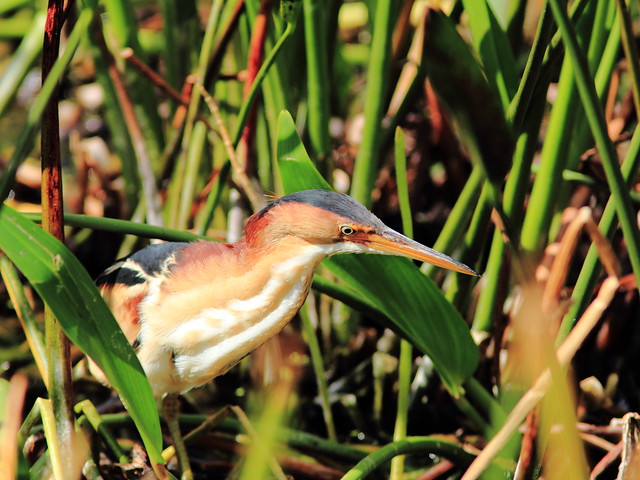
Who can pass up a photo-op with a Purple Gallinule…
…or a Glossy Ibis in breeding plumage?
This immature Little Blue Heron is changing into adult garb.
The Blue-winged Teal were fighting over mates, but these two males are getting along peacefully.
Pied-billed Grebes take advantage of the richness of prey in the waters.
Purple Martins are busy bringing nesting material into their apartments.
A White-winged Dove looks down from a pine tree.
American Coots are plentiful, but hey, they’re birds too!
Posted by: Ken @ 4:49 am
It was just another ho-hum Old MacDonald morning out on the wetlands, with only common birds species that would not thrill some of our “Robo-Birder” friends. At least we got home before the rains came.
Walking the same birding patch every morning is not boring. It is a bit like singing “Old MacDonald Had a Farm.” There is a certain joy in its familiarity, its cadence, the repetition. With each verse, you know what comes next– usually.
This morning, before sunrise, Mary Lou and I step a few doors from our South Florida home, exit the subdivision gate, and after ducking through a gap in the fence we set foot on on the coarse gravel of the road leading into the wetlands, It will soon become a busy thoroughfare. As usual, there is a pattern to our bird sightings.
As expected, a White-winged Dove is singing “Who cooks for you?” to its mate on a back yard fence along the way. It’s too dark for photography, but I crank the ISO up to 1600 and pull off a shot anyway.
Another predictable bird, a juvenile White Ibis walks on a roof, but this morning its graceful movement along the ridge tiles imparts delicate beauty.
We stop on the road and cast an anxious look back at the storm clouds gathering over the ocean. This is not a morning to venture deep into the wetlands.
The reliable abandoned telephone pole hosts two of its reliable tenants, an Osprey and an American Kestrel.
The same old Eastern Towhee is singing in the roadside bushes.
When we reach Harbour Lake, the sun is rising behind us.
The first rays are reaching the tops of thick clouds that are forming over the Everglades to the west. We will soon be surrounded by storms.
The weather may be closing in, but sunlight reaches the surface of the lake. The usual Great Egret poses nicely in the usual spot.
Near it is just another plain old brown Mottled Duck. “With a quack-quack here and a quack-quack there…”
An American Coot, usually seen swimming and diving, now shows off its long, lobed toes.
“Here a Myrtle, there a Palm, everywhere a yellow-butt…” Ready to depart, this representative of the Western race of Palm Warblers, so drab all winter, is changing into brighter breeding colors.
A Prairie Warbler breaks the monotony.
“With a chip-chip here and a chip-chip there, everywhere a chip-chip…” Look! what is THAT? A Pied -billed Grebe with a snake?
No, not a snake. This grebe is struggling with a creature that on closer examination exhibits a vertically flattened tail and external appendages or gills– a type of salamander, probably a Southern Dwarf Siren (Pseudobranchus axanthus), or possibly an Amphiuma species (another eel-like aquatic salamander). “Sirens are generally eel-like in form, with two tiny, but otherwise fully developed, forelimbs. They range from 25–95 cm (9.8–37 in) in length.[1] They are neotenic [they retain juvenile physical characteristics well into maturity– Ken] , although the larval gills are small and functionless at first, and only adults have fully developed gills. Because of this, it is most likely sirens have evolved from a terrestrial ancestor that still had an aquatic larval stage. Like amphiumas, they are able to cross land on rainy nights” (Ref: Wikipedia).
At first the grebe holds the siren near its middle, and it wiggles violently. The grebe dives and stays under for several seconds, then comes up with the siren grasped near its head. The siren is still contorting as the grebe attempts to swallow it. The grebe disappears under the water with its prey and surfaces somewhere out of sight, so I do not know the outcome of the struggle.
Speaking of snakes, a couple of days ago at this same spot I saw this Ring-necked Snake, about 11-12 inches in length. (The first time I saw one in Florida I thought I had discovered a new species unknown to science– certainly not something I had seen back home in New Jersey or New Mexico.) I blocked its escape and then captured it by hand.
As soon as I held the snake it stopped trying to escape and coiled, belly-up, exposing its bright yellow and orange undersides. It remained motionless as if playing dead, but when I turned it over, it immediately resumed the belly-up position.
It hid its head among the coils.
I watched from a distance as the snake slowly uncoiled and slithered away.
Posted by: Ken @ 9:47 pm
The sun had not yet crept above the horizon when we set out on the gravel road that leads into the wetlands next to our South Florida home. Mary Lou set a fast pace as usual, and again I fell behind. In her haste she walked right by an abandoned power pole along the road without seeing something interesting. Probably I saw it because the first rays were just hitting as I approached the pole. It was an immature Bald Eagle. I called her cell phone, but by the time she answered the eagle had flown away.
I also stopped to see whether any Bobcats were prowling on the levee. Finding none, I turned back towards the road and captured the rising sun with my compact point-and-shoot Canon PowerShot A1100 IS. The photo turned out very poorly, as the sky was over-exposed and the foreground was almost black. I tried to salvage the photo by using HDR software and got surreal results.
A Northern Cardinal perched in the high grass along the lake.
Common Ground-Doves foraged in the path near the heron rookery. They were quite timid, so I could only get a distant view.
The rookery is situated along the opposite (east) side of a canal. There have been as many as six adult and two immature Yellow-crowned Night-Herons roosting and displaying there this past week. This morning I found five adults, plus a pair of courting Green Herons. I was disappointed to see that maintenance crews from the South Florida Water Management District had applied herbicide to the vegetation along the bank of the canal.
Note the well-demarcated line of brown and denuded branches along the water line. The dead and dying trees are mostly exotic and invasive Brazilian Pepper which crowd out native trees. Most of last year’s heron nests were well-hidden in these trees, usually over the water. In these photos two herons can be seen at one of last season’s nest sites, well within the herbicide-treated zone.
The herons have already been carrying sticks to their old nest sites. Unless the trees recover, their nests and young will be totally exposed. I wonder whether they may now abandon the site.
Unaware of the problem, the herons continued to carry out their courtship rituals, this one on the remains of last year’s nest.
Note the bright red legs of the male heron.
This could be interpreted as a disagreement, but birds cannot change their facial expressions.
It looks as if they have now reconciled their differences!
Time to tend to the plumes.
Here is one of the Green Herons.
I hesitated about posting information about this rookery, discovered last spring by my neighbor, Scott. There is danger of unnecessary intrusion. Yet almost every evening and all weekend there are “recreational” motorists on ATVs and dirt bikes roaring along the west side of the canal, exactly where I stood to take these photos, only about 30 yards away from the rookery. Sure enough, a few birders contacted me and I guided them to see the herons.
One visitor this week was Steven Siegel, who was a consultant and videographer for the movie “The Big Year.” (Coincidentally, Mary Lou and I had just viewed the DVD the night before, and I did not learn of Steve’s involvement until after I met him. By the way, we really enjoyed the movie, accepting the fact that it is a comedy that must be taken with the proverbial grain of salt.) You may view an interesting and informative interview with Steven Siegel here: The Z Bird Birding Blog Interview with Steven Siegel, “The Big Year” Videographer
Posted by: Ken @ 9:32 am
As spring approaches, we are ever more alert for signs of changes. Most are subtle– the browning and fall of mahogany leaves, replaced within a week by soft new green growth; gradual decrease in the water levels of lakes and wetlands; disappearance of the kingfishers. Others are more dramatic, such as huge flights of Tree Swallows and gatherings of Yellow-rumped Warblers. Warbler flocks must be scrutinized, but so far we see only “Myrtles,” Palm Warblers and an occasional Prairie, Black-and-white or Orange-crowned Warbler. We listen for the early migrants, notably the Louisiana Waterthrush. We cannot help but see new signs of human disturbance.
Our birding “patch” consists of Everglades wetlands habitat that had originally been “reclaimed” by draining, and converted to pastures. By the end of the 20th Century, residential development pushed westward some 20 miles from the Atlantic coast to the edge of the Everglades preserve. The land was then set aside as a water conservation preserve by developers of our subdivisions to mitigate the environmental disturbance they created.
Ditches were blocked and low levees were put up around it. Exotic trees such as Melaleuca, Australian Pine and Brazilian Pepper were removed, but there has been no maintenance of this effort since about 2005, so it is already overrun by these invasive plants. Since it is separated from the Everglades preserve by high levees and US-27, its hydroperiod (the average number of days each year that it is covered by water during the summer through fall wet season) only weakly resembles that of the historic Everglades. There is no sheet flow as in the “River of Grass,” and the water level is dependent upon rainfall and local storm water discharge.
Although January was almost completely dry, there was unusually heavy rainfall during the past month. The prairie around the largest lake would normally be drying up by early March. Water would be more confined to ditches and sinkholes, concentrating aquatic prey and providing a rich food source for long-legged wading birds. Because of the higher water levels, these birds are still dispersed in the wetlands.
By this time of year, this trail across the prairie would normally be muddy but not under water. Now it is even too wet to be used by off-road vehicles which created the deep ruts in past years.
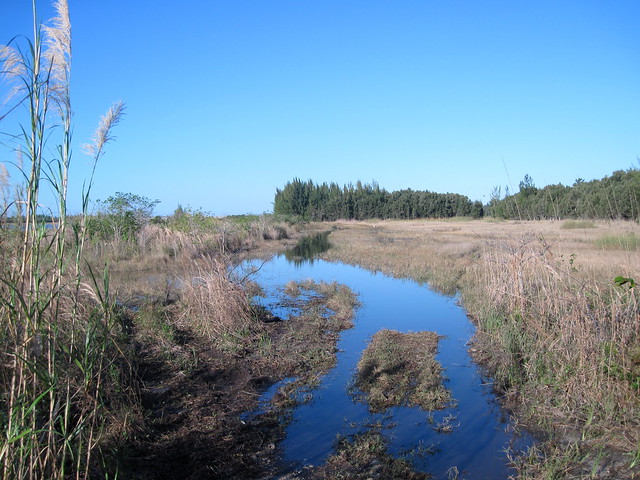
Although we rarely meet other people on our early morning walks, the area is fairly accessible to dog walkers, bicyclists and off-road vehicles. Young people especially like to drive their all-terrain vehicles (ATVs) into the wetlands and just have fun getting covered in mud. Some are more destructive. This past weekend they cut a path clear through the formerly dark and quiet little grove of Trema trees that I call the “Fake Hammock.” This is the only dry woodland near the entire four square miles of the preserve. They constructed a fire ring and started a pretty hot fire that charred the green leaves above and opened the canopy where I liked to sit and wait for the warblers to arrive. (See: “Birding in a make-believe hammock.”) We hesitate to complain to authorities, as their “solution” to the problem may simply be to clear away all the trees.
It’s not all bad. A couple of years ago, by running in tight circles (”donuts”) the RV cowboys dug a fairly deep hole in one low spot. It remained wet almost the entire year. This artificial “alligator hole” attracted Swamp Sparrows, Marsh Wrens and this Northern Waterthrush, among the first birds I photographed after I got my telephoto lens in 2008.
Our local preserve faces much more sweeping changes in the years ahead. The mile-long stretch of gravel road by which we access the eastern part of the area is slated to be paved and turned into a four-lane boulevard. Since it will form a much-needed link between I-75 and US-27, we can expect it to carry very heavy traffic. Only the economic downturn has stalled the completion of the roadway.
Further, within the next ten years, the entire area will be surrounded by high levees and turned into a huge reservoir, to be called the “C-9 Impoundment.” The upland areas will be inundated by 4 to 6 feet of water. The destruction of this habitat is for a good cause, as it will limit seepage of storm water from the Everglades and help restore sheet flow. Terrestrial species such as Raccoons, Gray Foxes and Bobcats will pay the price.
Early one morning I came across this traveler on the roadway, who was not happy when he saw me approaching. He hissed loudly “Oh, Shhhhhhhhh-t” (Alright, I didn’t hear the first word, but I knew he meant it). Of course I carried this Florida Box Turtle safely to the grassy roadside. He disappeared quickly into the dense grass.
Last spring, after I left for Illinois, my neighbor Scott discovered a rookery across the 196th Avenue Canal, at the far northern end of our patch. He counted about 5 nests of Yellow-crowned Night-Herons as well as one belonging to a Green Heron and another to an Anhinga. Most of the nests were rather low, on branches that extended over the water. Since then, someone built a small fishing platform right next to one of the nest sites.
Yellow-crowned Night-Herons were one of my “nemesis birds” when I birded in New Jersey during the 1940s and ’50s. At that time they were very uncommon summer visitors to coastal areas. My inland home town of Rutherford held the distinction of being the first place in New Jersey where this species was identified, albeit belatedly. The Bronx Zoo collected several immature herons there in the early 1900s and one of them, upon attaining adult plumage, was identified as a Yellow-crown. Try as I did, I never saw one anywhere in the state, though they now nest in a few isolated colonies along New Jersey’s southern Atlantic coast.
This past week I visited and found that at least four adult and one sub-adult Yellow-crowned Night Heron were roosting there. As I slowly approached the bank opposite the herons, one looked straight at me and ruffled out its plumes. At the same time it squacked abruptly. I thought it might have been a threat display. I had never seen this before.
Luckily my camera was ready to catch another display sequence. Maybe it was more of a mating display, but why was one directed at me?
The two herons displayed to each other. Their crowns were indeed yellow– they usually look white.
Another watched from the top of a small tree. Until this week, this is how I thought Yellow-crowned Night-Herons always looked!
The bird in immature plumage posed nicely next to an adult. Note the thick, short bill that helps distinguish the Yellow-crowned from the Black-crowned Night Heron.
I took so many photos that it was difficult to find a favorite. Although this one was in soft focus, I particularly liked the action.
For reference, here is a Google Map section of our patch. The unpaved highway is shown in yellow, and the limits of the planned C-9 Impoundment are outlined in the red dashed line. The green lines are two favorite birding paths. The 196th Street Canal runs along just east of the levee trail. For the most recent CERP report on the construction schedule for the Broward County Water Preserve Areas Project Implementation Report, visit: http://www.evergladesplan.org/pm/projects/docs_45_broward_wpa_final_pir.aspx
As a follow-up to my last post, about my new “Yard Bird” which cost me a small fortune, the poor thing had to put up with the indignity of having a Great Blue Heron use him as a fishing platform!














